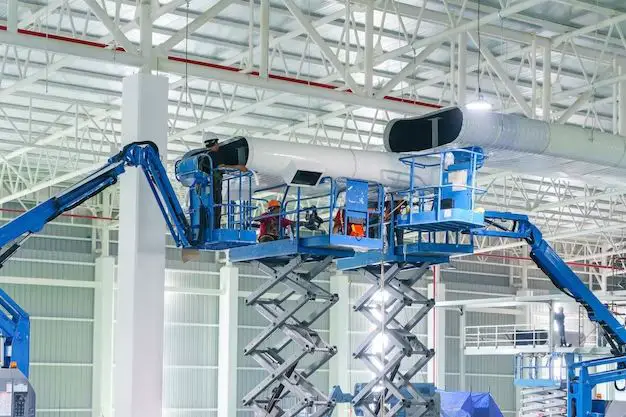When installing or repairing ductwork for HVAC systems, you need secure and stable methods for hanging the ducts. Ductwork must be properly supported to ensure proper airflow, reduce stress on connections, and prevent sagging. There are several good options for hanging ducts, depending on your specific needs and setup.
Page Contents
Strapping
One of the most common and cost-effective options for hanging ductwork is metal strapping. Strapping is available in different widths like 1/2″, 1″, or 2″ galvanized metal. Strapping is rigid enough to hold ducts securely but is still flexible enough to bend around structures and make turns. It has holes punched along its length so it can be secured with screws, bolts, or wire.
Strapping hanging methods include:
- Attaching strapping horizontally across ceiling joists or trusses then lowering ducts to rest on the strapping.
- Running strapping vertically up walls or columns to support ducts coming off the ceiling.
- Wrapping strapping around cylindrical ducts to act as clevis hangers.
Pros:
- Inexpensive compared to other hanging options.
- Readily available at hardware and HVAC supply stores.
- Easy to install and adjust.
- Can support ducts up to diameters of around 20″.
Cons:
- Not as durable or rigid as steel channel or angle iron.
- Requires more frequent attachment points than other hangers.
- Not suitable for very large or heavy ductwork.
Channel Iron
Steel channel iron provides a very sturdy and rigid support system for hanging ducts. Channel iron is shaped like a squared-off C with each side being 1 to 2 inches wide. It is thicker and heavier than strapping. Channel iron hanging methods include:
- Bolting lengths horizontally between ceiling joists.
- Welding pieces vertically to steel I-beams.
- Attaching specialized duct hangers to the channel that wrap around the duct.
Pros:
- Very strong and durable.
- Can support large commercial ducts up to 40″ diameters.
- Does not bend or sag under heavy loads.
- More visually appealing than strapping.
Cons:
- More expensive than strapping.
- Not as easy to install around complex routes.
- Can transmit vibrations more easily than strapping.
Angle Iron
Angle iron is formed from steel into an L shape with each side being 1 to 2 inches wide. It provides similar benefits as channel iron but is even stronger when used vertically. Angle iron hanging uses include:
- Bolting horizontal lengths between joists.
- Welding vertical pieces to steel beams.
- Attaching specialized angle iron duct hangers.
Pros:
- Extremely rigid and durable.
- Can support very large commercial ductwork.
- Does not bend or sag.
- Easier to install vertically than channel iron.
Cons:
- More expensive than other hanging options.
- Not as easy to install around complex routes.
- Can still transmit vibrations.
Wire
Hanging ducts with steel wire or cable can provide a flexible, adjustable support system. Wire hanging methods include:
- Attaching eye bolts to ceiling joists.
- Connecting wire or cable between eye bolts.
- Using cable clamps to support ducts from the wire cable.
Pros:
- Very adjustable for positioning ductwork.
- Allows ducts to be hung from high and inaccessible places.
- Can support long duct runs with fewer attachment points.
- Comparatively inexpensive.
Cons:
- Not as durable or rigid as steel channels or angle iron.
- Can stretch over time leading to duct sagging.
- Difficult to tension and level properly.
- Only suitable for low pressure ductwork.
Conduit Straps
Metal conduit straps provide an alternative to typical metal strapping for hanging ducts. Conduit straps are designed specifically for gripping and securing cylindrical objects like pipes or ducts. Typical conduit strap hanging includes:
- Bolting rows of conduit straps horizontally between ceiling joists.
- Placing ducts into the cradles formed by the straps.
- Tightening the conduit strap bolts to secure the ducts.
Pros:
- Hold ducts more securely than typical metal strapping.
- Gripping cradle design prevents lateral duct movement.
- Inexpensive and readily available.
- Easy to install and adjust.
Cons:
- Maximum duct diameter support is 20″.
- Not as rigid or durable as steel channels or angle iron.
- More difficult to place around complex routes.
Threaded Rod
Hanging ductwork with threaded steel rod provides maximum adjustability for positioning and leveling ducts. Threaded rod hanging uses include:
- Bolting threaded rod hangers into ceiling joists.
- Running threaded rod vertically from hangers.
- Securing ducts to threaded rod using nuts and washers.
Pros:
- Fully adjustable duct positioning, spacing, and height.
- Allows ducts to be precisely leveled.
- Can accommodate duct movement such as expansion and contraction.
- Comparatively inexpensive.
Cons:
- Time consuming to properly install and adjust.
- Not as rigid or durable as metal channel or angle iron.
- Only suitable for low pressure ductwork.
- Looks cluttered when installed.
Factors When Selecting Duct Hangers
When selecting a hanging method, consider factors like:
- Duct size – Larger ducts require more rigid hangers like channel iron or angle iron.
- Duct material – Flexible duct can use strapping but rigid metal ducts need stronger support.
- Structural supports – Hangers like threaded rod allow hanging ducts from bar joists or I-beams.
- Appearance – Some applications require more aesthetically pleasing hangers.
- Cost – Wire and strapping are least expensive, steel channels and angle iron most expensive.
- Ease of installation – Strapping is easiest for simple routes, threaded rod for tricky routes.
- Vibration reduction – Strapping and threaded rod best reduce transmission of duct rumble.
Conclusion
Properly hanging ductwork is crucial for HVAC efficiency and longevity. Choosing the right hanging method for the job saves time, money, and problems down the road. Strapping and conduit straps work for most residential ductwork. Channel iron, angle iron, or threaded rod give maximum support for demanding commercial duct installations. With all the available options, installers can hang ducts securely and effectively.

